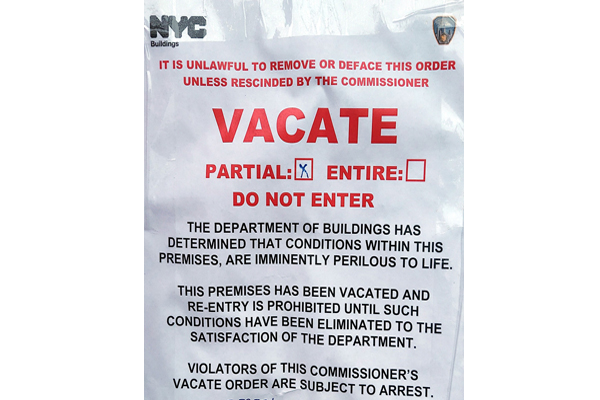Vacate Orders in NYC: What Property Owners Must Know
1) What is a Vacate Order?
A Vacate Order is an enforcement notice posted by a NYC agency—commonly the Department of Buildings (DOB), Housing Preservation & Development (HPD), or FDNY—when conditions are or may become imminently hazardous to life, safety, or property. It can be partial (limited areas) or full (entire premises).
Key point: Once posted, entry is prohibited except for authorized personnel performing approved corrective work.
2) Why are Vacate Orders issued?
- Structural hazards: damage, instability, or collapse risks.
- Fire & life safety hazards: blocked egress, illegal conversions, unsafe electrical/gas.
- Unauthorized/illegal work: unpermitted alterations that compromise safety.
- Adjacent dangers: unsafe neighboring conditions affecting your building.
3) How long do they last?
A Vacate Order remains in effect until all unsafe conditions are corrected and the issuing agency formally rescinds the order after reinspection. Timelines depend on scope of work, permit needs, inspection availability, and promptness of documentation.
4) Penalties & legal risks
- Civil penalties: significant fines for violating or ignoring the order.
- Criminal exposure: removing seals or allowing unlawful occupancy can trigger misdemeanor charges.
- Liens: tenant relocation costs advanced by the City may become liens if unpaid.
Note: Penalty amounts and processes can change—always verify current rules or consult a professional.
5) Tenant impacts & services
Tenants must vacate affected areas until the order is lifted. In coordinated cases, limited access may be arranged to retrieve essentials when safe.
- Emergency housing may be available via City/partners in certain situations.
- Relocation costs billed to owners can accrue as liens if not paid.
- Clear communication with tenants reduces disruption and liability.
6) Owner action plan (step-by-step)
- Secure the site: restrict access and stabilize obvious hazards.
- Engage pros: retain a licensed design professional and qualified contractors.
- File corrections: obtain any required permits; submit plans and documents promptly.
- Coordinate with the agency: request reinspections; provide evidence of corrections.
- Close out penalties: pay outstanding civil penalties/fees and address relocation invoices.
- Document everything: keep notices, logs, and photo evidence for your records and insurers.
Our Typical Removal Workflow
- 48-hour hazard assessment & compliance roadmap
- Permit strategy (Emergency Work Orders when applicable)
- Corrective work coordination & milestone updates
- Reinspection scheduling & on-site representation
- Final rescission support + proof of compliance package
7) Frequently Asked Questions
No. A Stop Work Order halts construction work. A Vacate Order requires people to leave part or all of the premises due to unsafe conditions. You can have one without the other—or both together.
The notice will specify the restricted areas. Partial means only listed portions are off-limits; full means the entire property must be vacated until rescinded.
In many cases, limited, supervised access can be arranged when conditions allow. Coordinate with the issuing agency and your design professional to ensure safety.
Clear scope, complete filings, responsive communication, and timely inspection requests. Emergency permits and temporary shoring can also reduce risk and delays.
Received a Vacate Order?
Time matters. We help assess hazards, file corrections, and coordinate reinspections to lift Vacate Orders fast.
